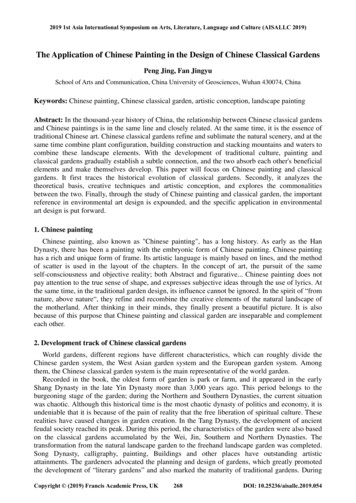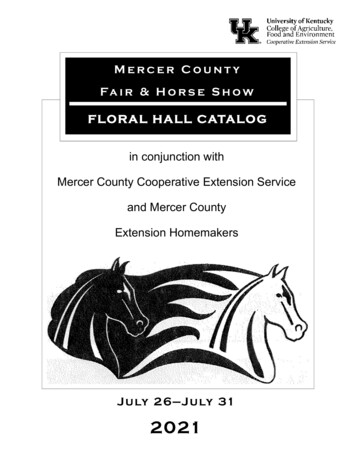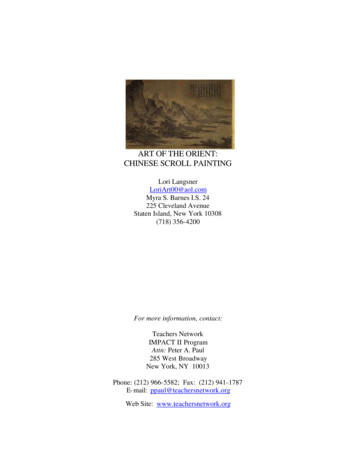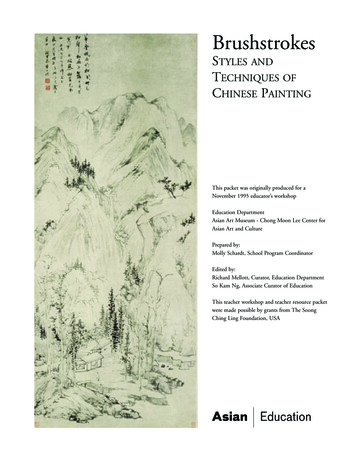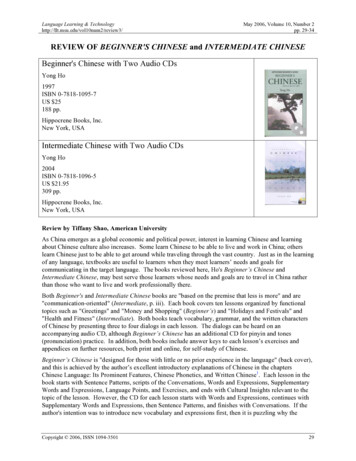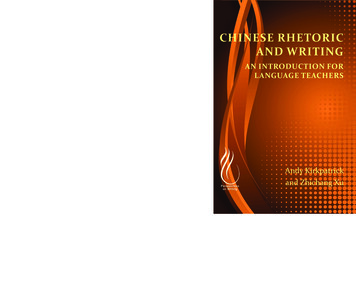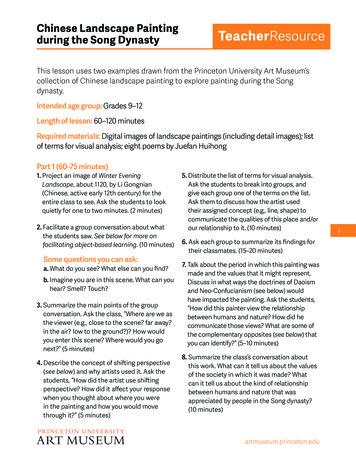
Transcription
Chinese Landscape Paintingduring the Song DynastyTeacherResourceThis lesson uses two examples drawn from the Princeton University Art Museum’scollection of Chinese landscape painting to explore painting during the Songdynasty.Intended age group: Grades 9–12Length of lesson: 60–120 minutesRequired materials: Digital images of landscape paintings (including detail images); listof terms for visual analysis; eight poems by Juefan HuihongPart 1 (60–75 minutes)1. Project an image of Winter EveningLandscape, about 1120, by Li Gongnian(Chinese, active early 12th century) for theentire class to see. Ask the students to lookquietly for one to two minutes. (2 minutes)2. F acilitate a group conversation about whatthe students saw. See below for more onfacilitating object-based learning. (10 minutes)Some questions you can ask:a. What do you see? What else can you find?b. I magine you are in this scene. What can youhear? Smell? Touch?3. Summarize the main points of the groupconversation. Ask the class, “Where are we asthe viewer (e.g., close to the scene? far away?in the air? low to the ground?)? How wouldyou enter this scene? Where would you gonext?” (5 minutes)4. Describe the concept of shifting perspective(see below) and why artists used it. Ask thestudents, “How did the artist use shiftingperspective? How did it affect your responsewhen you thought about where you werein the painting and how you would movethrough it?” (5 minutes)5. Distribute the list of terms for visual analysis.Ask the students to break into groups, andgive each group one of the terms on the list.Ask them to discuss how the artist usedtheir assigned concept (e.g., line, shape) tocommunicate the qualities of this place and/orour relationship to it. (10 minutes)6. A sk each group to summarize its findings fortheir classmates. (15–20 minutes)7. Talk about the period in which this painting wasmade and the values that it might represent.Discuss in what ways the doctrines of Daoismand Neo-Confucianism (see below) wouldhave impacted the painting. Ask the students,“How did this painter view the relationshipbetween humans and nature? How did hecommunicate those views? What are some ofthe complementary opposites (see below) thatyou can identify?” (5–10 minutes)8. S ummarize the class’s conversation aboutthis work. What can it tell us about the valuesof the society in which it was made? Whatcan it tell us about the kind of relationshipbetween humans and nature that wasappreciated by people in the Song dynasty?(10 minutes)artmuseum.princeton.edu1
Chinese Landscape Paintingduring the Song DynastyPart 2 (60–75 minutes)1. Divide the class into eight groups. Give eachgroup images of one painting from Eight Viewsof the Xiang and Xiao Rivers, including detailimages. Have them discuss everything theysee and everything they imagine they canhear, smell, and touch. (5–10 minutes)2. G ive each group the poem by Juefan Huihongthat corresponds to their painting. Ask themto read it and discuss with their group howit connects to the painting. What sensesdoes the poet engage? How does the poemcompare to their list of things they could see,hear, smell, and touch? (5 minutes)3. N ext, have them identify pairs ofcomplementary opposites in the painting.(For example, in River and Sky in EveningSnow: mountain vs. river, rising mist vs. fallingsnow, stillness of snow vs. activity of market.)(5 minutes)TeacherResource4. H ave the entire class regroup, and ask eachgroup to present “their” painting to theirclassmates, noting the elements that theyfound most important in their response to thework. (25–40 minutes)5. D escribe for the students the format of ahandscroll and how it would be “read.” Whatis the progression of scenes in their painting?How would the viewer journey through thisspace as he unrolled/rerolled the scroll? (5minutes)6. C onclude the conversation by projecting animage of the hanging scroll and one of thehandscroll scenes. What emotions do thepainters convey in these scenes? What is therelationship between humans and nature? (10minutes)artmuseum.princeton.edu2
A Closer Look: Chinese LandscapePainting during the Song DynastyTeacherResourceWhat is it?Landscape painting dominated Chinesepainting beginning in the tenth century. Theword for landscape painting in Chinese, shanshui hua, literally means “mountain (shan)water (shui) painting (hua).” Mountains arehard and unyielding; water is soft and fluid.These opposites are an example of the conceptof yin and yang—the idea that everything innature is composed of complementary butopposing forces that interact and change.Complementary opposites is one of severalcore cultural concepts of the Song dynastythat are encapsulated in many of the period’slandscape paintings.Two traditional formats for Chinese painting arethe hanging scroll and the handscroll (otherformats include fans and album leaves). In bothcases, artists painted with ink and coloredpigments on silk, which was then mounted onanother piece of silk. A hanging scroll is usuallya vertical composition. Hanging scrolls are hungfrom the wall using a cord, which is attached toa wooden strip at the top of the scroll. Hangingscrolls are not displayed indefinitely but aretaken down to be stored, rolled up, when notin use. A handscroll is usually several meters inlength and is used for horizontal compositions.It is kept rolled up and only brought out forviewings. To “read” the paintings, the viewerunrolls the scroll from right to left to journeythrough the landscape.Chinese landscape paintings are about natureon a grand scale and about humans’ role in theuniverse. The act of looking is a contemplativeexperience. The viewer is invited to wanderthrough the landscape and to identify with anyhuman figures that are depicted. Handscrolls,both in the unrolling of the scroll and in thevisual meandering through it, offer a differentexperience of time than hanging scrolls do.Artists paid as much attention to the unpaintedareas of their compositions as they did to thedetailed sections. The empty, or negative, spacesare just as important as the painted, or positive,areas. Artists varied their brush techniques tocreate thin or thick lines, and the layers of inkprovide variations in tone that suggest differenttextures or distances from the viewer at differentpoints in the scene.The first work, Winter Evening Landscape by LiGongnian, is a hanging scroll. At the bottom(the front of the space, closest to us), treesstripped of their leaves grow on and next toseveral outcroppings of rock. At the top (theback of the space), mountains appear out ofthe mist and clouds. Li contrasted the powerfulmonumentality of the mountains with theephemerality of the mist. He varied his brushstrokes to convey the delicate texture of the baretree branches and the solid forms of the rock.The second work, Eight Views of the Xiao andXiang Rivers, is a set of two handscrolls by WangHong. The popular theme of the eight views wascredited to Song Di (ca. 1015–ca. 1080), a scholarofficial and painter. Although Song Di’s workdid not survive, it was well known at the time.Many artists painted versions of the eight viewsinspired by Song Di. Princeton’s scrolls appear tobe the earliest of these paintings still in existencetoday. The paintings and their associated poeticlabels (by an anonymous author) inspired theBuddhist monk Juefan Huihong (1071–1128) toartmuseum.princeton.edu3
Chinese Landscape Paintingduring the Song Dynastywrite poems that evoke evening and autumnalscenes. Wang Hong’s paintings, which date toabout 1150, were thus inspired by both Song Di’spaintings and Juefan Huihong’s poems. The lushand mountainous Xiao–Xiang region was seenas a place of retreat or even exile, and the poemsand paintings convey the duality of a sense ofmourning or loss in a space of great beauty.The use of first-person perspective in some ofthe poems, coupled with the small figures inthe paintings, encourages the viewer to imaginethemselves in the scene. Chinese paintingsoften incorporate “shifting perspective,” whichpresents a point of view that moves up anddown, near and far (in contrast to the fixedperspective used in the West). In Wang Hong’sEight Views of the Xiao and Xiang Rivers, forexample, the distant mountain peaks aredepicted so that they appear to be level withthe viewer, accentuating the sense that theyare situated at the edges of the horizon.Alternatively, the villages and groupings ofboats are painted as though from a birdseye perspective. These multiple viewpointsencourage the viewer’s eyes to wander throughthe scene. We look across at the distant areas,and we look down at the paths that humanstravel. The shifting perspective also heightensthe emotional impact of the paintings. Themountains appear to loom over the viewer, whilethe distant areas—painted with a wash of ink—are hazy and indistinct.Who made it?Political contextThe history of imperial China is marked by therise and fall of successive dynasties, or lines ofrulers descending from the same family. Thesetwo works were made during the Song dynasty,TeacherResourcea period of cultural refinement that also lookedback to the artistic achievements of the Tangdynasty (618–907) in the arts of poetry, painting,and sculpture. Rebellions in the mid-eighthand ninth centuries weakened the dynasty’sability to defend itself, and it collapsed in theearly tenth century. After the collapse of theTang dynasty, the north of China was dividedinto five kingdoms during what is known as theFive Dynasties period. A general from one ofthe dynasties, Zhao Kuangyin, succeeded inunifying China. He established the Song dynasty(960–1279) and ruled as the Taizu Emperor.The Taizu Emperor put civil, not military, officialsin charge of the government in order to preventthe rise of leaders who might challenge his rule.This change led to the position of the scholarofficial (shi), collectively called the literati, anda rigorous system of civil examinations. Literatiwere expected to cultivate their skills in the artsof calligraphy, poetry, and painting. The scholarofficial was one of four classes in society; theothers were landowners and farmers, craftsmenand artists, and merchants and tradesmen.Scholars, poets, and painters—many of whomhad retreated into nature during the periodof political disintegration—now came to thecapital city, Bianliang (modern Kaifeng) fromother parts of unified China, bringing with themthe artistic traditions of the Tang dynasty.The Song dynasty was raided by the Jurchen Jin,a dynasty to the north of the Song, in 1125. Thecapital was destroyed, and many members of thecourt were captured. The dynasty reorganizedin the south, with a new capital city at Lin’an(present-day Hangzhou). (A map is available atColumbia University’s Asia for Educators 4
Chinese Landscape Paintingduring the Song DynastyPhilosophical contextDuring the Song dynasty, three religiousphilosophies, known as the three doctrinesor three teachings, were seen as operating inharmony: Daoism, Buddhism, and Confucianism.Dao means “The Way”—the path to immortality,the origin of the world, and the progenitor of theforces of yin and yang. According to Daoism,humans do not preside over nature, nor was naturecreated for humans’ benefit. Instead, humansmust learn to live in harmony with nature. NeoConfucianism flourished during the SouthernSong. This philosophy advocated for a return to thebasics of Confucian teachings. Followers soughtto refine their inner selves through their searchfor absolute truth in nature. Two key concepts areli, the governing principle that gives each thing itsinherent nature, and qi, the vital force or energythat occupies all things.The artistsWe do not know much about either of these artists.Li Gongnian was a prison official in Hangzhou.The Princeton University Art Museum’s painting isthe only surviving authenticated work by him. Hissignature and seal are on a rocky outcrop beneaththe cliff at the right. Wang Hong was a professionalpainter from Shu (present-day Sichuan province)and possibly served at court. There are only a fewknown extant works by him, and he used a varietyof styles in these paintings.TeacherResourceWhat can it tell us about the culture thatmade it?After the disintegration of the Tang dynasty,many learned men retreated to the countryside,preferring to engage with nature rather thanwith the uncertainties found in urban centers.Even after the reunification of China in the Songdynasty, the literati still yearned to escape thepressures of daily life at court through retreatinto nature. If a person lived in a developedarea, looking at and contemplating a landscapepainting would give that person an opportunityto imagine being in and developing a harmoniousconnection with nature.Landscape paintings often contain symbolicmeaning. Mountains were considered the homeof the immortals and therefore sacred. Tall pinetrees symbolized the virtuous man, while atolling bell was a reference to the fleeting natureof human existence. In their presentation ofidealized forms from nature, landscape paintingsalso provide one way of exploring the principlesof li and qi. A landscape painting shows naturenot as the human eye sees it but according to theinherent principles of the natural world it depicts.The painted scene thus becomes a microcosm ofa moral and orderly universe.artmuseum.princeton.edu5
Focus ObjectsLi Gongnian (Chinese,active early 12th century),Northern Song Dynasty(960–1127), Winter EveningLandscape, ca. 1120. Hangingscroll; ink and light colorson silk, 129.6 x 48.3 cm(painting). Gift of DuBoisSchanck Morris, Class of1893 (y1946-191)Wang Hong (Chinese, active ca. 1131–ca. 1161),Southern Song Dynasty (1127–1279), Eight Viewsof the Xiao and Xiang Rivers, ca. 1150. Pair ofhandscrolls; ink and light colors on silk, 23.4 x 90.7cm (average for each painting). Edward L. ElliottFamily Collection. Museum purchase, FowlerMcCormick, Class of 1921, Fund (y1984-14 a–b) Wild Geese Descending to Sandbar Returning Sail off Distant Shore Mountain Market, Clear with Rising Mist River and Sky in Evening Snow Autumn Moon over Lake Dongting Night Rain on Xiao and Xiang Evening Bell from Mist-Shrouded Temple Fishing Village in Evening GlowTeacherResourceFacilitating Object-Based LearningThe goal of object-based learning is that studentsfind their own paths to answers through closelooking and discussion. Begin by giving thestudents a minute or two to look silently at theprojected image. Silence can sometimes beuncomfortable for both the teacher and thestudents, but resist the urge to speak before thetime has elapsed. This allows the students to lookclosely and find details that they might not havenoticed with just a cursory glance. When the timeis up, ask, “What do you think is going on here?” or,“Tell me what you see.” They should answer yourquestions based on what they see, using visualevidence to support their ideas. As their guide,your job is to ask them open-ended questions—that is, questions that do not have a yes or noanswer or an A or B answer. For example, ask,“What do you think is happening here?” instead of“Is this person playing an instrument?” or “Is thisa camel or a horse?” Rather than giving studentsthe answers outright, help guide them to a betterunderstanding by asking clarifying questionsor by making connections between students’observations. For example, if a student says thatshe thinks the objects are made out of wood, ask,“What do you see that makes you say that?” Askher to point to specific elements of what she seesthat make her think that they might be wood. Ifone student thinks that an animal is a horse andanother student thinks that it is a camel, ask thestudents to point to elements that might supportone hypothesis versus the other—for example,what might a camel have that a horse would not?You can provide additional information to fill in thegaps at the end of the conversation, but aim tohave the students uncover as much as they canfrom their own observations first.artmuseum.princeton.edu6
Focus ObjectsTerms for Visual AnalysisLine: A continuous mark with a length anddirection. Lines can be straight, wavy, broken, short,or long.Shape: The use of a line or lines to enclose space.Two-dimensional shapes can be organic (irregular)or geometric (shapes with strong lines and angles,such as circles, rectangles, and triangles).Space: The area around and between objects.Positive space refers to the space taken up by anobject; negative space refers to the space aroundthat object.Color: An aspect of the appearance of an objectand light sources that can be described by hue(what we would classify as red, orange, yellow, etc.),lightness (how much black or white is mixed intothe hue), and saturation (how pure or intense thehue is).TeacherResourceContrast: A large difference between two things,such as light and shadow.Scale/Proportion: Scale is a ratio usedto determine the relationship between arepresentation and the thing it represents;proportion describes the relationships amongparts of a whole.Mass/Volume: Mass refers to the amount ofmatter an object contains, while volume refers tothe amount of space it takes up. For example, aninflated balloon can have a low mass but a highvolume.Balance: The way that elements in a work of art arearranged to create a feeling of stability (or, if thereis a lack of balance, instability).Perspective: How an artist creates a sense ofdepth in a representation of space.Texture: The surface quality of an object—is itsmooth, rough, soft, bumpy, etc. In paintings,texture is often implied—that is, we imagine thata representation of a tree trunk is rough or bumpy,even if the paper it is painted on is smooth.artmuseum.princeton.edu7
A Closer Look: Chinese Landscape Painting during the Song Dynasty What is it? Landscape painting dominated Chinese painting beginning in the tenth century. The word for landscape painting in Chinese, shan shui hua, literally means "mountain (shan) water (shui) painting (hua)." Mountains are hard and unyielding; water is soft and fluid.


